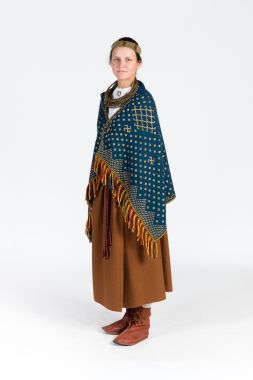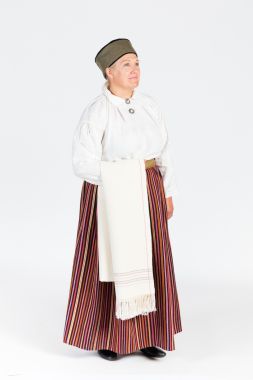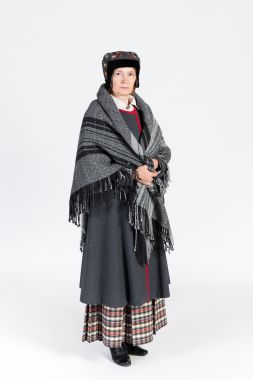Folk costumes
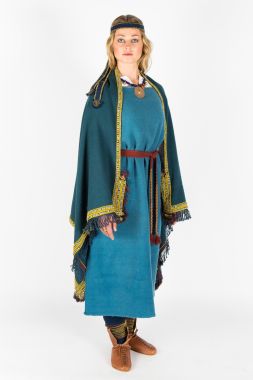
Reconstruction of the 13th century Vends woman's costume
The arrangement and the decoration of the Vends (a group of the Baltic Finnish population, referred to in the 13th century Chronicle of Henry of Livonia who lived in the North-western part of Kurzeme, but as a result of the Curonian expansion moved closer to Riga. They later settled within the territory populated by the Latgallians near Cesis) costume shares similarities to those of the Livs. In the 13th century the traditional decorations of the woolen shawls were complimented by yellow glass paste beads. They, together with small rings and rosettes, were used to border the edges of the fabric. Depending on the width of the decorative bands that bordered the fabric, tassels were formed along the edges and corners of the garment. The metal crown (vainags) was replaced by narrow decorated hair bands that tied behind the head. Metal decorations were included on the ends of belts, however the adornments in general, were simpler and used in smaller numbers at this time. Typically found adornments from this period consisted of a special decorative pin and bead necklaces – the beads threaded onto metal wires.
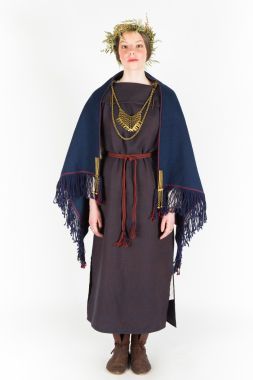
Interpretation of the 11th century Semigallian woman’s costume
Information about the Semigallian costumes used in ancient times is limited as those textiles barely survived over the centuries. We do know that metal decorations were seldom used in their costumes but that one of the recognizable elements in Semigallian woolen shawls were the small metal spiral pendants. The way these spiral pendants were made, where they came from or how they were attached to the garments is undetermined. The most characteristic adornment of a Semigallian woman was the cruciform pin, which was used to fasten the skirt where it folds over below the shoulders.
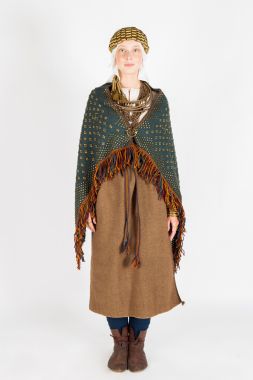
Reconstruction of the 11th -12th century Latgallian woman’s costume
The costume of the 11th and 12th century Latgallian woman is characterized by an ornate woolen shawl and a rich range of ornaments, which showed the garment wearer's special position in society. The dark blue woolen shawl is entirely covered by bronze decorations and pinned at the chest with a brooch. A metal crown and neck rings were the most luxurious adornments and were worn in large numbers along with decorations made of chain. The hands were adorned by spiral armbands and many finger-rings.
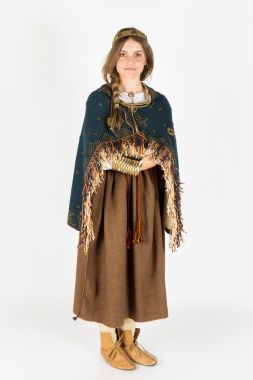
Reconstruction of the 12th century Selonian woman's costume
Selonian women’s festive clothing and adornments resembled Latgallian costumes. The Selonian women's shawls were richly decorated by interwoven bronze ornaments, often covering the entire length of the cloth. Along with these decorated shawls, simpler shoulder blankets made of plain wool cloth were used- embellished only by colorful threads woven along the garment's edge for decoration.

Women’s Winter Clothing from Tūja
• Krekls – taisna piegriezuma garš (līdz puslielam) ar baltu izšuvumu un atlokāmu apkakli;• Brunči – jostasvietā brīvās krokās sakrokoti kupli brunči, audums svītrains vai rūtains;• Jaka – ar nedaudz pagarinātu jostasvietu un faltīm;• Galvassega – siltā ziemas cepure;• Kāju āvums – adītas garās (līdz celim) zeķes, baltas vai svītrainas;• Rotas – krekla aizdarei lieto nelielu saktiņu vai auduma lentītes.
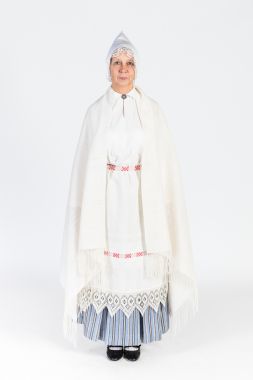
Married Women’s Summer Clothing from Tūja
• Krekls – taisna piegriezuma garš (līdz puslielam) ar baltu izšuvumu un atlokāmu apkakli;• Brunči – jostasvietā brīvās krokās sakrokoti kupli brunči, audums svītrains vai rūtains;• Villaine – austa balta lina villaine;• Galvassega – cepure ar izšūtu tilla mežģīni;• Kāju āvums – adītas garās (līdz celim) zeķes, baltas vai svītrainas;• Rotas – krekla aizdarei lieto nelielu saktiņu vai auduma lentītes.
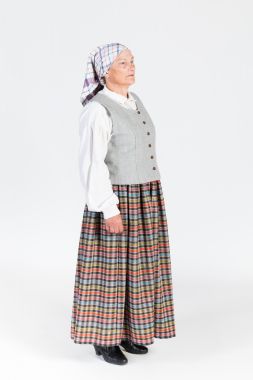
Women’s Summer Clothing from Tūja
• Krekls – taisna piegriezuma garš (līdz puslielam) ar baltu izšuvumu un atlokāmu apkakli;• Brunči – jostasvietā brīvās krokās sakrokoti kupli brunči, audums svītrains vai rūtains;• Veste – īsa, pieguļoša piegriezuma;• Galvassega - pašausts kokvilnas/lina rūtains lakatiņš, kuru var valkāt pēc vēlēšanās – atsiet atpakaļ, sasiet zem zoda vai aptīt ap galvu;• Kāju āvums – adītas garās (līdz celim) zeķes, baltas vai svītrainas;• Rotas – krekla aizdarei lieto nelielu saktiņu vai auduma lentītes.
